清华大学:《分子生物学》课程PPT教学课件(基因ene)第十二章 复制子(The replicon)
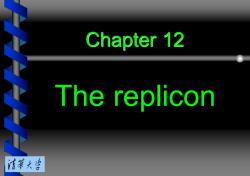
Chapter 12 The replicon 清革大当
Chapter 12 The replicon

12.1 Introduction 12.2 Replicons can be linear or circular 12.3 Origins can be mapped by autoradiography and electrophoresis 12.4 The bacterial genome is a single circular replicon 12.5 Each eukaryotic chromosome contains many replicons 12.6 Isolating the origins of yeast replicons 12.7 D loopsmaintain mitochondrial origins 12.8 The problem oflinear replicons 12.9 Rolling circles produce multimers of a replicon 12.10 Rolling circles are used to replicate phage genomes 12.11 The F plasmid is transferred by conjugation between bacteria 12.12 Conjugation transfers single-stranded DNA 12.13 Connecting bacterial replication to the cell cycle 12.14 Cell division and chromosome segregation 12.15 The division apparatus consists of cytoskeletal and regulatory components 12.16 Partitioning involves membrane attachment and(possibly)a motor 12.17 Multiple systems ensure plasmid survival in bacterial populations 12.18 Plasmid incompatibility is determined by the replicon 12.19 The ColEl compatibility system is controlled by an RNA regulator 清菜大当
12.1 Introduction 12.2 Replicons can be linear or circular 12.3 Origins can be mapped by autoradiography and electrophoresis 12.4 The bacterial genome is a single circular replicon 12.5 Each eukaryotic chromosome contains many replicons 12.6 Isolating the origins of yeast replicons 12.7 D loops maintain mitochondrial origins 12.8 The problem of linear replicons 12.9 Rolling circles produce multimers of a replicon 12.10 Rolling circles are used to replicate phage genomes 12.11 The F plasmid is transferred by conjugation between bacteria 12.12 Conjugation transfers single-stranded DNA 12.13 Connecting bacterial replication to the cell cycle 12.14 Cell division and chromosome segregation 12.15 The division apparatus consists of cytoskeletal and regulatory components 12.16 Partitioning involves membrane attachment and (possibly) a motor 12.17 Multiple systems ensure plasmid survival in bacterial populations 12.18 Plasmid incompatibility is determined by the replicon 12.19 The ColE1 compatibility system is controlled by an RNA regulator
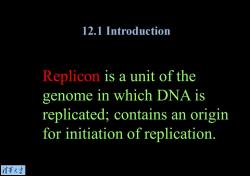
12.1 Introduction Replicon is a unit of the genome in which DNA is replicated;contains an origin for initiation of replication. 清苇大兰
Replicon is a unit of the genome in which DNA is replicated; contains an origin for initiation of replication. 12.1 Introduction
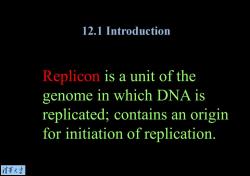
12.1 Introduction Replicon is a unit of the genome in which DNA is replicated;contains an origin for initiation of replication 情華大当
Replicon is a unit of the genome in which DNA is replicated; contains an origin for initiation of replication. 12.1 Introduction
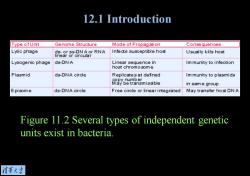
12.1 Introduction Type ofUnit Genome Structure Mode of Propagation Consequences Lytic phage ds-or ss-DN A or RNA Infeats susceptible host Usually kills host linear or circular Lysogenic phage ds-DNA Linear sequence in Im munity to infection ho寸chrom0some Plasmid ds-DNA cirde Replicates at defined Im munity to plasmids Mabe tarsmissble in same group Episome ds-DNA circle Free circle or linear integrated May transfer host DNA Figure 11.2 Several types of independent genetic units exist in bacteria. 清苇大当
Figure 11.2 Several types of independent genetic units exist in bacteria. 12.1 Introduction
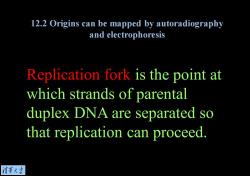
12.2 Origins can be mapped by autoradiography and electrophoresis Replication fork is the point at which strands of parental duplex DNA are separated so that replication can proceed. 情華大当
Replication fork is the point at which strands of parental duplex DNA are separated so that replication can proceed. 12.2 Origins can be mapped by autoradiography and electrophoresis
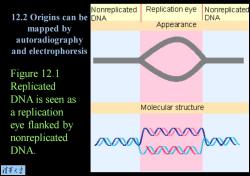
Nonreplicated Replication eye Nonreplicated 12.2 Origins can be DNA DNA mapped by Appearance autoradiography and electrophoresis Figure 12.1 Replicated DNA is seen as a replication Molecular structure eye flanked by nonreplicated DNA. 清苇大当
Figure 12.1 Replicated DNA is seen as a replication eye flanked by nonreplicated DNA. 12.2 Origins can be mapped by autoradiography and electrophoresis

UNIDIRECTIONAL REPUCATION 12.2 Origins can be mapped by O autoradiography G Replication fork and electrophoresis 入八A 八入Replicated DNA Parental DNA Figure 12.2 Replicons BIDIRECTIONAL REPLICATION may be unidirectional or bidirectional, depending on whether one or two replication Replication fork Replication fork forks are formed at the origin 情華大当
Figure 12.2 Replicons may be unidirectional or bidirectional, depending on whether one or two replication forks are formed at the origin. 12.2 Origins can be mapped by autoradiography and electrophoresis
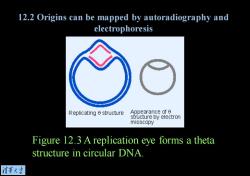
12.2 Origins can be mapped by autoradiography and electrophoresis Replicating e structure Appearance of e structure by electron mioscopy Figure 12.3 A replication eye forms a theta structure in circular DNA. 清苇大当
Figure 12.3 A replication eye forms a theta structure in circular DNA. 12.2 Origins can be mapped by autoradiography and electrophoresis
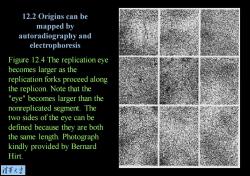
12.2 Origins can be mapped by autoradiography and electrophoresis Figure 12.4 The replication eye becomes larger as the replication forks proceed along the replicon.Note that the "eye"becomes larger than the nonreplicated segment.The two sides of the eye can be defined because they are both the same length.Photograph kindly provided by Bernard Hirt. 情華大当
Figure 12.4 The replication eye becomes larger as the replication forks proceed along the replicon. Note that the "eye" becomes larger than the nonreplicated segment. The two sides of the eye can be defined because they are both the same length. Photograph kindly provided by Bernard Hirt. 12.2 Origins can be mapped by autoradiography and electrophoresis
按次数下载不扣除下载券;
注册用户24小时内重复下载只扣除一次;
顺序:VIP每日次数-->可用次数-->下载券;
- 清华大学:《分子生物学》课程PPT教学课件(基因ene)第十一章 噬菌体的战略(Phage strategies).ppt
- 清华大学:《分子生物学》课程PPT教学课件(基因ene)第十章 操纵子(The operon).ppt
- 清华大学:《分子生物学》课程PPT教学课件(基因ene)第九章 转录(Transcription).ppt
- 清华大学:《分子生物学》课程PPT教学课件(基因ene)第八章 蛋白质定位(Protein localization).ppt
- 清华大学:《分子生物学》课程PPT教学课件(基因ene)第七章 遗传密码的利用(Using the genetic code).ppt
- 清华大学:《分子生物学》课程PPT教学课件(基因ene)第六章 蛋白质合成(Protein synthesis).ppt
- 清华大学:《分子生物学》课程PPT教学课件(基因ene)第五章 信使RNA(Messenger RNA).ppt
- 清华大学:《分子生物学》课程PPT教学课件(基因ene)第四章 簇和重复(Clusters and repeats).ppt
- 清华大学:《分子生物学》课程PPT教学课件(基因ene)第三章 有多少基因(How many genes are there).ppt
- 清华大学:《分子生物学》课程PPT教学课件(基因ene)第二章 从基因到基因组(From Genes to Genomes).ppt
- 清华大学:《分子生物学》课程PPT教学课件(基因ene)第一章 基因是DNA(Genes are DNA).ppt
- 清华大学:《分子生物学》课程PPT教学课件(基因ene)绪论 Molecular Biology(主讲:王钊).ppt
- 河北农业大学:《分子生物学》课程教学资源(PPT课件)第十二章 免疫多样性产生的机制.ppt
- 河北农业大学:《分子生物学》课程教学资源(PPT课件)第十一章 病毒的分子生物学.ppt
- 河北农业大学:《分子生物学》课程教学资源(PPT课件)第十章 遗传重组.ppt
- 河北农业大学:《分子生物学》课程教学资源(PPT课件)第九章 真核生物基因表达调控.ppt
- 河北农业大学:《分子生物学》课程教学资源(PPT课件)第八章 原核生物基因表达调控.ppt
- 河北农业大学:《分子生物学》课程教学资源(PPT课件)第七章 蛋白质翻译(Protein Translation).ppt
- 河北农业大学:《分子生物学》课程教学资源(PPT课件)第六章 RNA转录(RNA transcription).ppt
- 河北农业大学:《分子生物学》课程教学资源(PPT课件)第五章 DNA损伤、修复和突变.ppt
- 清华大学:《分子生物学》课程PPT教学课件(基因ene)第十三章 DNA复制(DNA replication).ppt
- 清华大学:《分子生物学》课程PPT教学课件(基因ene)第十四章 重组和修复(Recombination and repair).ppt
- 清华大学:《分子生物学》课程PPT教学课件(基因ene)第十五章 转座子(Transposons).ppt
- 清华大学:《分子生物学》课程PPT教学课件(基因ene)第十六章 逆转录病毒和逆转座子(Retroviruses and retroposons).ppt
- 清华大学:《分子生物学》课程PPT教学课件(基因ene)第十七章 DNA的重新排列(Rearrangement of DNA).ppt
- 清华大学:《分子生物学》课程PPT教学课件(基因ene)第十八章 染色体(Chromosomes).ppt
- 清华大学:《分子生物学》课程PPT教学课件(基因ene)第十九章 核小体(Nucleosomes).ppt
- 清华大学:《分子生物学》课程PPT教学课件(基因ene)第二十章 转录的起始(Initiation of transcription).ppt
- 清华大学:《分子生物学》课程PPT教学课件(基因ene)第二十一章 转录的调控(Regulation of Transcription).ppt
- 清华大学:《分子生物学》课程PPT教学课件(基因ene)第二十二章 核的剪切(Nuclear splicing).ppt
- 清华大学:《分子生物学》课程PPT教学课件(基因ene)第二十三章 催化RNA(Catalytic RNA).ppt
- 清华大学:《分子生物学》课程PPT教学课件(基因ene)第二十四章 免疫多样性(Immune diversity).ppt
- 清华大学:《分子生物学》课程PPT教学课件(基因ene)第二十五章 蛋白质间的开放交通(Protein trafficking).ppt
- 清华大学:《分子生物学》课程PPT教学课件(基因ene)第二十六章 信号的传输(Signal transduction).ppt
- 清华大学:《分子生物学》课程PPT教学课件(基因ene)第二十七章 细胞循环和生长调控(Cell cycle and growth regulation).ppt
- 清华大学:《分子生物学》课程PPT教学课件(基因ene)第二十八章 致癌基因和癌症(Oncogenes and cancer).ppt
- 清华大学:《分子生物学》课程PPT教学课件(基因ene)第二十九章 梯度、级联和发信号的途径(Gradients, cascades, and signaling pathways).ppt
- 四川大学:《植物生物学》课程教学资源(教案讲义)第一章 植物的细胞和组织.pdf
- 四川大学:《植物生物学》课程教学资源(教案讲义)第二章 植物体的形态结构和发育.pdf
- 四川大学:《植物生物学》课程教学资源(教案讲义)第三章 植物的无机营养.pdf
